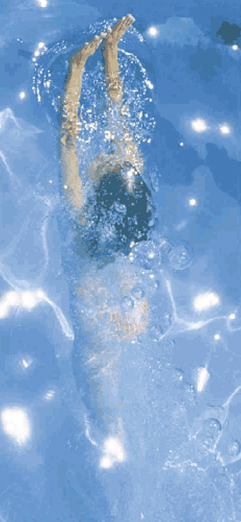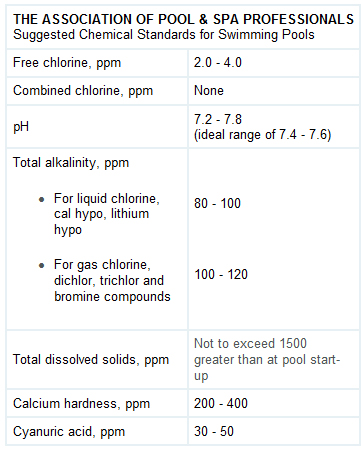 Mastering the knack of pool science is not difficult with the right information and a little diligence. As for those readers who are experienced poolside chemists, put this article in the hands of anyone learning the ropes.
Mastering the knack of pool science is not difficult with the right information and a little diligence. As for those readers who are experienced poolside chemists, put this article in the hands of anyone learning the ropes.
Think of the perfect swimming pool and visions of sparkling water and happy swimmers likely dance in your head. Keeping this scene intact involves taking the proper steps to sanitize the pool and prevent any health or aesthetic problems. The water will then remain clear of algae, free of disease causing pathogens and users won't complain about red eyes or chlorine smell.
Because you use chlorine, whether you're responsible for running a public facility or a water park, you have the necessary tools to make your job easier. For general pool treatment, chlorine has three essential characteristics: it acts as a rapid and persistent sanitizer, an effective algaecide and a strong oxidizer of undesired contaminants.
Understanding the role of chlorine in maintaining safe water is not difficult once you learn the basics of pool chemistry.
Intro to Chlorine
Chlorine is regularly fed into the pool water and should be tested daily—at a minimum—for proper disinfection. Routine chlorination kills harmful microorganisms that can cause health-related problems, such as gastroenteritis, Legionnaires disease, ear infections and athlete's foot. Learning how to properly test your water will allow you to identify the chlorine residual and demand in pool water. More frequent testing is needed if there is heavy bather use.
Listed below are some helpful definitions that will assist you in understanding the terms and tasks of applying chlorine-based sanitizers.
- Free available chlorine (FAC). The portion of the total chlorine remaining in chlorinated water that has not reacted with contaminants—and is "free" to go to work to kill bacteria and other contaminants. Make sure your test kit can measure FAC; many only test for total chlorine.
- Combined available chlorine (CAC) or chloramines. The portion of chlorine in the water that has reacted and combined with ammonia, nitrogen-containing contaminants and other organics such as perspiration, urine and other swimmer waste. Some chloramines can cause eye irritation and chlorine odors.
- Total chlorine. The sum of both the free available and combined chlorines.
 Forms of chlorine commonly used in commercial pools. Pools are treated with chlorine gas, sodium hypochlorite (liquid bleach), calcium hypochlorite (granular or tablet), lithium hypochlorite or chlorinated isocyanurates. When any of these compounds contact water, they release hypochlorous acid (HOCl), the active sanitizing agent. Chlorinated isocyanurates, a family of chemical compounds such as sodium dichloroisocyanurate and trichloroisocyanurate, also add cyanuric acid or stabilizer. A stabilizer, which can also be added separately, helps reduce excess loss of chlorine in water due to the ultraviolet rays of the sun.
Forms of chlorine commonly used in commercial pools. Pools are treated with chlorine gas, sodium hypochlorite (liquid bleach), calcium hypochlorite (granular or tablet), lithium hypochlorite or chlorinated isocyanurates. When any of these compounds contact water, they release hypochlorous acid (HOCl), the active sanitizing agent. Chlorinated isocyanurates, a family of chemical compounds such as sodium dichloroisocyanurate and trichloroisocyanurate, also add cyanuric acid or stabilizer. A stabilizer, which can also be added separately, helps reduce excess loss of chlorine in water due to the ultraviolet rays of the sun. - Parts per million (ppm). Measurement that indicates the parts of a substance, such as chlorine, by weight in relation to one million parts by volume of pool water. A rule of thumb to follow to maintain good water quality in pools is to keep FAC levels between 2.0 and 4.0 ppm. (see NSPI recommendation chart)
- Shock treatment. The practice of adding significant amounts of an oxidizing chemical to water to destroy ammonia, nitrogen-containing and organic contaminants. Adding chlorine as a shock treatment can also control algae and bacteria, but read the label to make sure that your product can do this.
Basic Steps for Pool Treatment
To learn more, view the pool safety video below and visit this page for free pool chemical safety resources.
Carefully read and follow the manufacturer's instructions printed on the chlorine treatment package. Test the water regularly—it's a simple process to use a test kit. You want to maintain water balance by measuring:
- Free available chlorine (FAC), which should be in the range of 2 - 4 ppm, but never fall below 1.0 ppm
- Total chlorine, to assure that combined available chlorine (CAC) levels are less than 0.2 ppm
- The pH level to keep it between 7.2 and 7.8, indicating that the chlorine is working effectively
- Total alkalinity to make sure that pH levels stay steady
- Calcium hardness to protect pool surfaces from corrosion.
How Much of What?
The guidelines set by The Association of Pool & Spa Professionals are widely used, but to be certain, you should also check the health codes of the jurisdiction where you live. The chemicals a pool needs to maintain the required standards differ from pool to pool—and day to day. Keeping records to "get to know" a pool can help you interpret its characteristics and perform the correct task.

Shock Treatment
Contrary to what most people think, a strong chlorine smell is not an indication of too much chlorine in the pool but actually a red flag that a "super dose" may be required to correct the problem.
Shock treatment adds a larger than normal amount of oxidizing chemicals to pool water. This additional dose destroys organic contaminants and oxidizes ammonia and nitrogen compounds to rid the area of irritating chloramine odor and, if chlorine is used for the purpose, to sanitize the water. Many chlorine shock products also provide usage instructions for destroying algae and bacteria, which can be an added benefit. Shocking should be done with the pump and filter operating, but after sundown to avoid the loss of chlorine to the sun's ultraviolet (UV) rays.
Superchlorination is another term that is sometimes used for shock treatment with chlorine products when 5 or more ppm of FAC is added. This mode of shock treatment—in addition to oxidizing undesired wastes—is used to rid the pool of algae and bacteria that might be hiding in filters and hard-to-sanitize areas. Superchlorination also gets rid of chloramine odor. Adding 10 times the level of combined chlorine or chloramines in the water achieves so-called breakpoint chlorination when there is enough extra chlorine to consume the irritating chloramines.
According to NSPI standards for public pools, the ideal frequency for a super dose is every week, depending on use and water temperature. For high use pools, superchlorination may be required three times a week or more as a preventive measure. NSPI also suggests that a good indicator of the need for a super dose is when combined chlorine climbs near or above 0.2 ppm.
More on Chlorine
As you learn your way around the pump room, you'll appreciate chlorine's importance in contributing to safe, clean water—making those visions of swimming in a sparkling, clear pool a reality.
Basic Rules of Thumb
- Always read and follow the manufacturer's instructions.
- Store chemicals in a cool, dry and shaded place.
- Never mix different types of chlorine—add each to the pool separately.
- Never mix chemicals together—add each to the pool separately.
- Avoid breathing fumes or vapors.
- Don't buy more pool chemicals than you'll use in a season - they lose effectiveness over time.
- Make sure pool chemicals are inaccessible to children.
Cost-Savers Tip
Save on chemical costs by adding chlorine for shock treatment after dark—during the day some will be lost to sunlight.